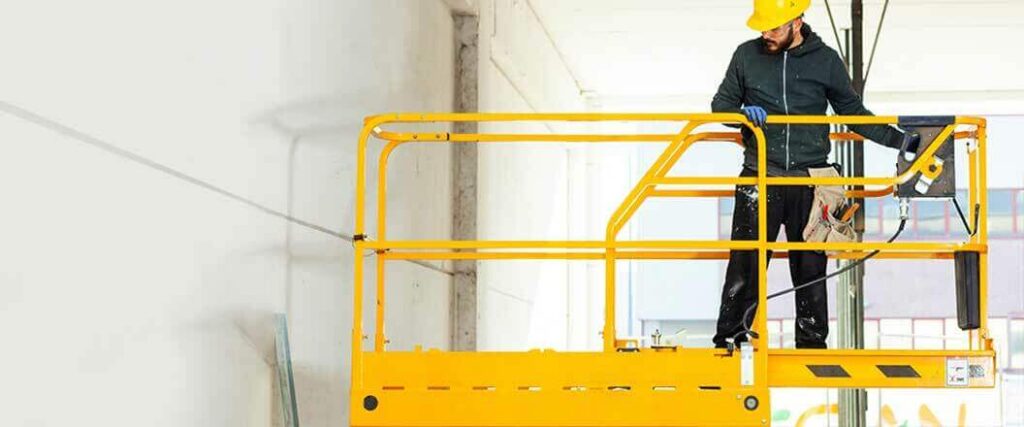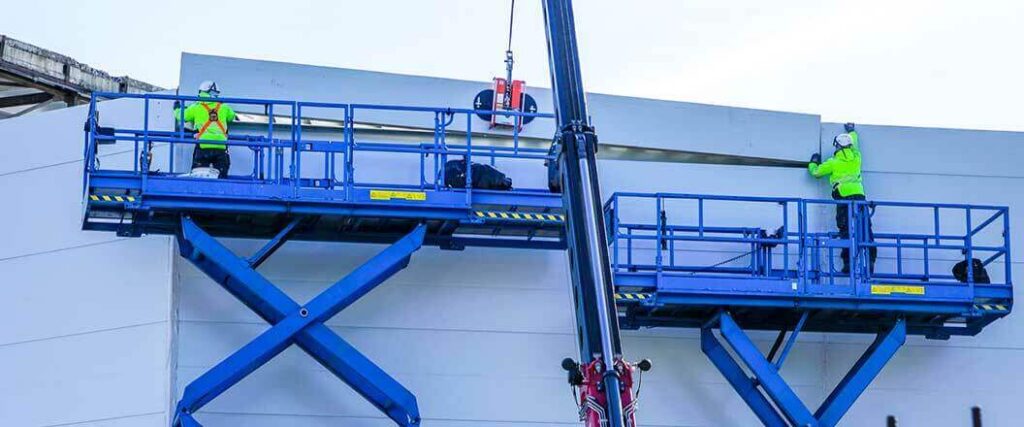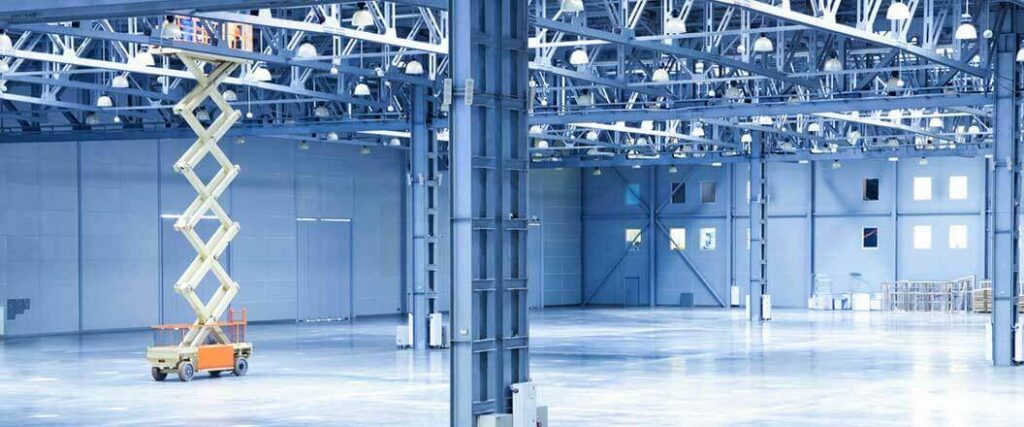Knowing how to transport a scissor lift is a concern for many construction and maintenance businesses. The equipment provides workers a safe and efficient way to access high places. However, moving these bulky and heavy machines requires the right trailer, equipment and correct safety procedures.
As per the guidelines from the Association of Equipment Manufacturers (AEM), scissor lift transport can be completed with the following steps:
When it comes to shipping this piece of equipment, businesses can expect to spend $200 to $800.
Construction companies can learn how to transport a scissor lift or find the right transport service to ship this type of equipment to different job sites.
Compared to other kinds of machines used at construction sites, scissor lifts are fairly easy to move. That said, preparation and transport should still be completed with care.
Construction businesses should always inspect their equipment before preparing it for transport. Ensuring your scissor lift is in prime condition guarantees a smoother transport process and minimizes potential repair costs.
Shippers should do the following:
Businesses should check for corrosion, especially in the joints and underbelly of the equipment. Look out for any dents or structural damage that might have occurred during previous operations, as this could worsen during transport.
After a general inspection, an operational check of their equipment will determine that all controls and switches are functioning correctly. Any malfunctions can complicate the loading and unloading process.
Scissor lifts come with built-in safety systems that protect the user, such as:
The mobility of a scissor lift is essential, especially when loading it onto a transportation vehicle. Therefore, construction businesses should inspect the tires and fill them with the correct amount of air pressure if needed.
All of this should be done prior to handing it off to a shipper for transport.
The scissor lift needs to be secured before being transported. This is a key step that prevents the lift from unfolding during transit, which could lead to accidents or damage.
Lock and secure your scissor lift with the following steps:
Next, focus on securing accessories and attachments that go with the equipment. These parts can be stored safely for transport—preferably in a locked storage box or container to prevent loss and damage. Afterward, take a final look over the scissor lift to identify any loose parts that haven’t been secured.
After a scissor lift has been put in place, you will need to disconnect the battery from the equipment. Separating the power source is essential for a few different reasons.
This includes:
Disconnecting the power source is actually a straightforward process. The battery compartment is usually found under the lift's main body or in a side compartment. A wrench can be used to loosen the battery terminals.
Secure the disconnected cables so they don't touch one another or any metal surfaces. This reduces the risk of damage to the electrical system during transport and prevents anyone from accidentally engaging any of the machine’s functions.
Once the scissor lift has been secured and parts have been locked down, the next essential step is to ensure that there are no loose items remaining. If anything is left unsecured, it could create a variety of hazards for carriers and other drivers on the road.
For the most part, the final securing is carried out by the shippers that will actually transport the lift to the next location.
Shippers that find any loose parts can use cable ties, bungee cords, or appropriate storage bins to secure the items. Documenting the parts that go with a scissor lift is another good practice. Keeping a list will help businesses ensure all the pieces that go with the equipment are identified and kept safe.

Shipping heavy and oversized equipment requires careful planning and coordination. Submit your quote form today and see how our specialists carefully coordinate your shipment’s arrival.

When organizing scissor lift transport services, there are legal precautions that business will need to consider. Certain shipping regulations are in place to ensure the safety of transport personnel and other drivers on the road.
Many scissor lifts are quite small, while others are extremely large. Therefore, it’s essential for construction businesses to consider legal weight and dimensional requirements.
This includes:
Every state has different legal requirements for the height, width, and length of cargo. However, most scissor lifts are well within licit dimensions. We’ve provided a table showing the usual measurements for this kind of equipment.
| Scissor Lift Type | Height (Retracted) | Width | Length |
| 19’ | 4.5’ | 2.6’ | 6’ |
| 26’ | 5.6’ | 3.10’ | 7’ |
| 32’ | 6.25 | 3.8’ | 8’ |
| 40’ | 8.1 | 4.5’ | 9’ |
| 50’ | 10.5 | 7.6’ | 10’ |
Provided by Genie, Cooper Equipment, and Sunbelt Rental
Scissor lift types are determined by the max height it can be extended. Equipment that can go higher will have larger dimensions. It should be noted that scissor lifts much larger than the ones provided. For example, 4-stage hydraulic and multi-stage scissor lifts for turbine assembly exceed the dimensions for the equipment we’ve provided.
The weight of a scissor lift should be considered too. As with dimensional regulations, every state has a legal weight requirement for cargo. Fortunately, many scissor lifts weigh somewhere between 2,700 to 17,000 pounds. These ranges are below the usual 80,000 pound limit set by many states.
If you are a manufacturer needing to ship several of these, weight may become a limiting factor. It will depend on the type and number of scissor lifts being shipped.
Scissor lifts that do exceed legal weight or dimensional requirements will have to be transported in accordance with oversized regulations. Many states require oversized loads to be accompanied by escort vehicles. Safety equipment like banners and lights are used as well.
When it comes to transporting oversized scissor lifts, securing the right documents is critical. These kinds of paperwork come in the form of overweight and oversize permits.
Construction businesses can contact the Department of Transportation (DOT) of the state(s) their freight is traveling through to get the document they need. Shippers should be prepared to provide specific details about the scissor lift on the paperwork.

There isn’t one scissor lift transport trailer that’s superior to all the rest. Larger equipment will require different accommodations for shipping.
This includes:
Tilt trailers can be angled to ground level, allowing the equipment to be driven on and off without a forklift. This removes the need for a dock. Car trailers work similarly by utilizing a deck that can tilt or by including a platform that equipment can drive on. These kinds of trailers are slightly larger than tilt variants.
When transporting larger scissor lifts, flatbeds and lowboys are the way to go. Flatbed trailers are versatile and can accommodate scissor lifts of various sizes. The open design also allows for loading and unloading on different sides of the equipment.
Lowboy trailers are lower to the ground than regular flatbeds. This prevents clearance issues for scissor lifts that are still extremely tall when retracted.
Scissor lifts cannot be transported while extended. This kind of equipment is designed to be moved only when in a fully retracted position. If scissor lifts were transported while extended, it would pose a serious safety risk for the carrier moving it and other drivers on the road.
Concerns include:
An extended scissor lift has a higher center of gravity, which increases the risk of equipment tipping over. Clearance is another problem that can occur. Extended scissor lifts can hit numerous obstructions like bridges or tree branches.

The cost to transport a scissor lift will vary greatly. We’ve provided some data to show how much it might cost to transport this kind of equipment.
| Type of Scissor Lift | Cost To Transport |
| 19’ | $200-$300 |
| 26’ | $300-$500 |
| 32’ | $400-$600 |
| 40’ | $500-$700 |
| 50’ | $600-$800 |
Based on industry averages
These amounts are just estimates. Costs to transport these scissor lifts can be more or less expensive. That said, shippers should expect to spend more money when moving larger equipment compared to smaller varieties.
The same holds true if more than one is being transported at once.
The cost to transport a scissor lift can vary widely, depending on a number of factors. Determining the exact price for shipping such heavy equipment requires an understanding of those factors. While all shipments are affected by distance and fuel costs, we’ll focus on the specific concerns that impact scissor lift shipping prices.
This includes:
Heavier and larger lifts cost more to transport because they require specialized trailers and may incur overweight fees. Compact equipment will usually be on the lower end of the cost spectrum due to the ease of transport.
Larger trailers tend to be more expensive to use than smaller ones. That said, this type of equipment can typically be transported on a trailer that’s more compact.
Urban areas might offer more competitive pricing due to the higher availability of transport services. On the other hand, remote or difficult-to-access locations may increase costs because of additional travel time and complexity.
For more on expenses, read our article on heavy haul rates.
As we've navigated the intricacies of how to transport a scissor lift, it's clear the task requires attention to detail, specialized equipment, and a seasoned hand. Fortunately, that's where Heavy Haul & Oversized comes in. We are the experts you need for a worry-free transportation experience, ensuring your equipment arrives safely, legally, and on time.
Here's how we stand out in facilitating your heavy haul needs:
With Heavy Haul & Oversized, you're choosing a partner who values your equipment's safety as much as you do. Our seasoned professionals are ready to tailor their services to your unique demands. Give us a call at (866) 902-2713 or fill out your quote to get your freight moving today!

Time and safety are crucial in shipping your heavy and oversized equipment. Fill out our quick quote form to get the right advice you need in no time!
Heavy Haul and Oversized
315 NE 14th Street #4122
Ocala, FL 34470